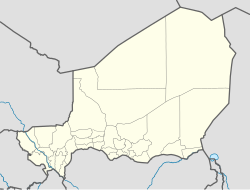Niamey
| Niamey | |
|---|---|

Niamey at night
|
|
| Coordinates: 13°31′17″N 02°06′19″E / 13.52139°N 2.10528°ECoordinates: 13°31′17″N 02°06′19″E / 13.52139°N 2.10528°E | |
| Country |
|
| Region | Niamey Urban Community |
| Communes Urbaines | 5 Communes |
| Districts | 44 Districts |
| Quartiers | 99 Quarters |
| Government | |
| • Type | Appointed district government, elected city council, elected commune and quarter councils |
| • Governor of Niamey Urban Community | Mrs. Kané Aichatou Boulama |
| • Mayor of Niamey City | Assane Seydou Sanda |
| Area Niamey Urban Community |
|
| • Total | 239.30 km2 (92.39 sq mi) |
| Elevation | 207 m (679 ft) |
| Population (2011) | |
| • Total | 1,302,910 |
| • Density | 5,400/km2 (14,000/sq mi) |
| Niamey Urban Community | |
| Time zone | WAT (UTC+1) |
| Area code(s) | 20 |
Niamey (French pronunciation: [njaˈmɛ]) is the capital and largest city of the West African country Niger. Niamey lies on the Niger River, primarily situated on the east bank. It is an administrative, cultural and economic centre. Niamey's population, which was estimated at 774,235 in 2006, is now projected to be much higher.
The city is located in a pearl millet growing region, while manufacturing industries include bricks, ceramic goods, cement and weaving.
Niamey was probably founded in the eighteenth century, but was of little importance to most of the country until the French developed a colonial post in the 1890s. This rapidly grew into an important centre. In 1926 it became the capital of Niger, and the population gradually increased, from about 3,000 in 1930 to around 30,000 in 1960. The period from 1970 to 1988 was one in which the economy of Niger boomed, driven by revenue from the uranium mines at Arlit. In this period, the population of Niamey grew from 108,000 to 398,365 inhabitants. The city expanded from 1,367 hectares (3,380 acres) in 1970 to 4,400 hectares (11,000 acres) by 1977, in the process annexing peripheral villages such as Lazaret.
By some estimates the population had reached 800,000 in 2000. In 2011, government press estimated the total urban population at over 1.5 million. A major cause of the increase has been in migration for work and during droughts, as well a high population growth. This last factor means a majority of the city's citizens are youths.
Covering an area of over 250 km2 (97 sq mi), the metropolitan area sits atop two plateaus reaching 218 m (715 ft) in altitude, bisected by the Niger River. At Niamey, the river, running almost straight SSE from Gao, makes a series of wide bends. The city was founded on the east ("left bank") of the river as it meanders from a west to east flow to run almost directly south. A series of marshy islands begin at Niamey and extend south in the river.
The climate is hot semi-arid (Köppen climate classification BSh), with an expected rainfall of between 500 mm (20 in) and 750 mm (30 in) a year, mostly beginning with a few storms in May, then transitioning to a rainy season, usually lasting from sometime in June to early September, when the rains taper off rather quickly. Most of the rainfall is from late June to mid-August. There is practically no rain from mid-October to April. Niamey is remarkably hot throughout the year. In fact, it is one of the hottest major cities on the planet. Average monthly high temperatures reach 38 °C (100 °F) four months out of the year and in no month do average high temperatures fall below 32 °C (90 °F). During the dry season, particularly from November through February, nights are generally cool. Average nighttime lows between November and February range from 14–18 °C (57–64 °F).
...
Wikipedia

